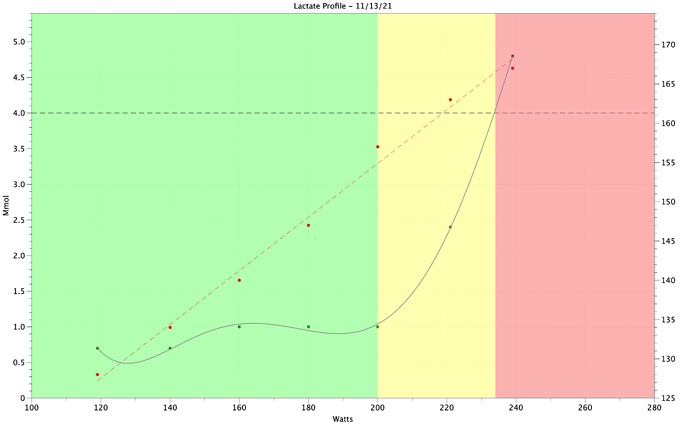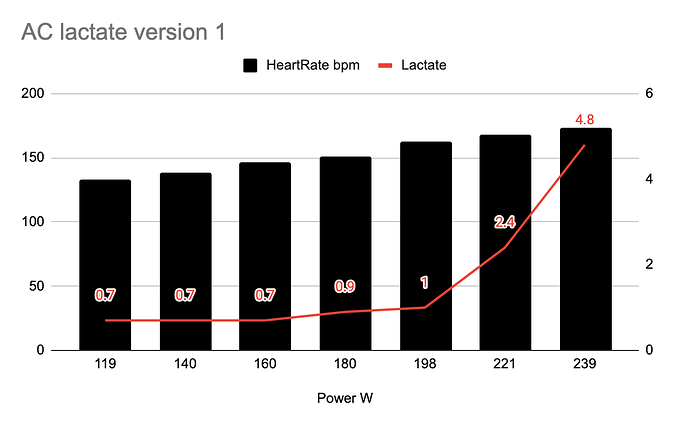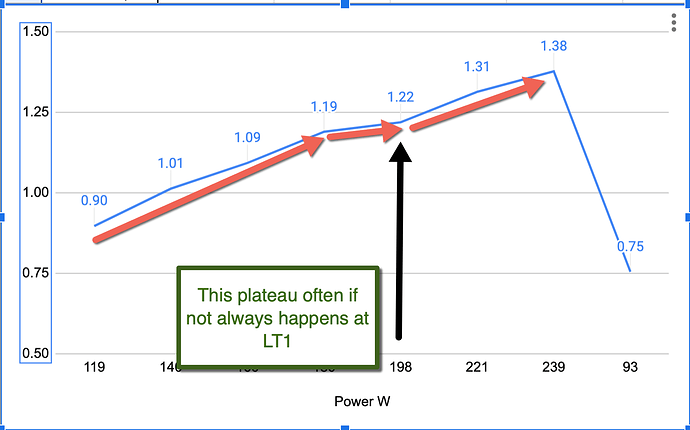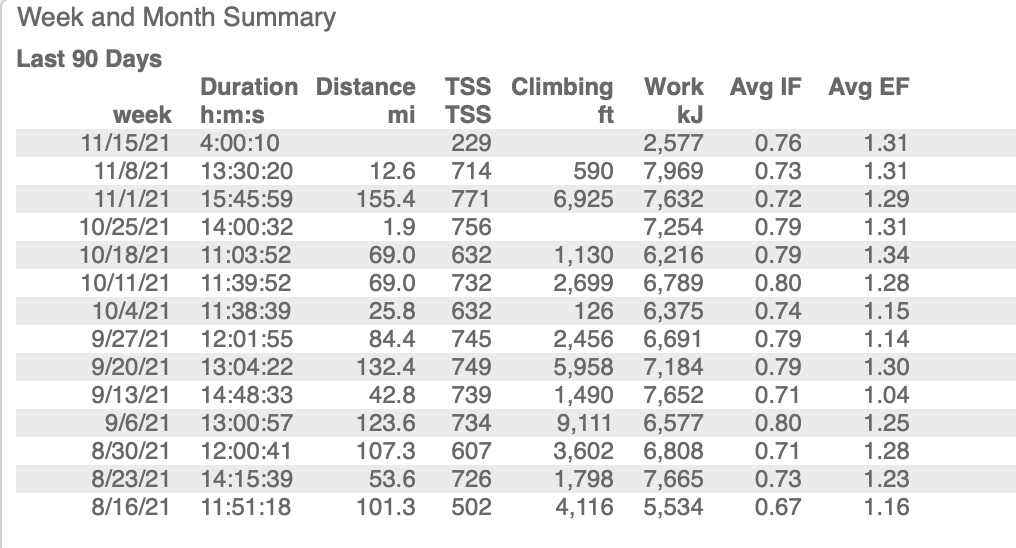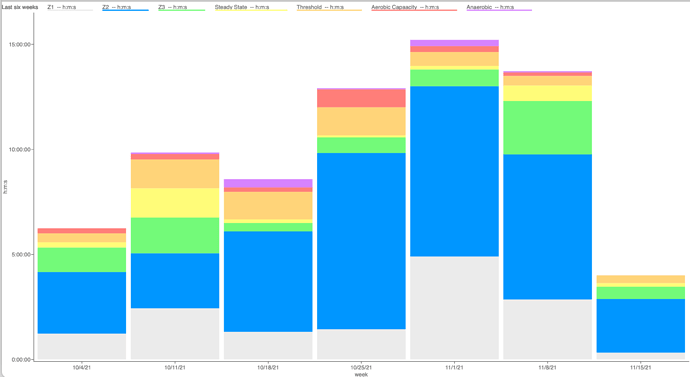Thanks for the feedback @steveneal , looking at this again I don’t think my protocol really works for LT1 as the increases in lactate for most people may be quite small going from below LT1 to tempo and sweetspot. I’ve always used 25W steps during my ramp tests but was trying to get a more accurate value for LT1. I guess just using the 10W steps I used without the 3 and 9 minute values would suffice for a more accurate value if required.
I would agree with your comment, @PeteD, regarding your protocol. If we look not only at within-stage lactate changes, but also stage to stage, you effectively have one “typical” stage between your 220w and 250w steps (30w) in the September test. Those changes in lactate between those 220w and 250w are large enough that you can still determine LT1, and moving to straight 25w stages with 10 min sample times would be just as good. I would do a 5 and 10 min sample on the 10 min stages and that should suffice.
You may have seen this other thread already, but have you used the DFA alpha1 protocol at all to look for LT1? It was a pretty lengthy discussion in one of our other posts on A New Detection Method Defining the Aerobic Threshold. I’ve been using it with in-person testing and when it works, it works well; it seems to be pretty tight with ventilatory and lactate responses in most athletes I’ve tested. Some we didn’t have much luck with, but that’s why it’s always good to have lactate and/or ventilatory measures too.
Thanks for the detailed response @ryan, I remember seeing the thread on DFA alpha 1 but will have revisit it again. I didn’t record ventilation during this test but it has corresponded reasonably well for me in the past
Good morning,
I was hoping some of the coaches (@steveneal and @ryan) might be able to help me interpret a lactate test I did this morning.
General info:
- Conducted after an overnight fast (one cup of coffee prior to starting the test)
- Eight-minute steps
- Resting value taken just before starting was .5 mmol
Notes
The first time through, I had a reading of 3.6 mmol for 200 watts. After seeing a value of 2.4 mmol for 220 watts, I re-did the 200 watt step and ended up with a value 1 mmol.
The fit (line) used is a polynomial function.
Intepretation
Nice, flat curve until LT1 which I put right at 200 watts. This is good. Pretty narrow Z2 (three-zone model) and no clear second inflection point. As a result, I’m using 4 mmol (dashed line) to approximate MLSS.
Questions
Is my assessment of the curve correct?
Typically, I think the focus would be to flatten out the curve. However, based on what I interpret as a narrow Z2, I’m not sure that’s the correct approach for me. I’m wondering if instead I should focus on work just below and/or above MLSS?
Generally, I feel I need to move the second turn point. My understanding is the two tend to move together. I guess I’m asking if there’s a limit? If at some point, LT1 has moved so close to LT2 (85% based on this curve), that’s it’s time to spend more time focusing on raising the roof. For reference, pVO2 Max per WKO5 is around 330 watts. So…
- LT1 → LT2 → MAP
- 200 → 235 → 330
If that makes sense.
Thank you!
Can you please share the fit file and lactates please
I am without internet mostly through December 1 so working on phone.
I would want to see LT2 at 75-85% of map determined from a 3m step test.
So 260 to 280 watts.
You would likely be able to improve that lt2 solely from tempo work but would require 2 to 3 days a week and 45-90m of tempo per session and the ability to stay entertained while doing so.
YOUR MAP is pretty solid at 330 but the steady tempo aerobic are has lots of room to improve.
Yessir!
FIT file and CSV sent to your email. I think you do 25-watt steps starting at like 150 and take the best minute power? I’m pretty sure I could get to a minute into the 325 step fresh. Will confirm at some point but my legs are pretty crap right now from all the maximal efforts last week.
Thanks so much for responding!
A few things here.
-
The lactates have errors, there just wouldn’t be two at .7 and 3 at 1.0 exactly, so for these were are likely just dealing with machine error.
-
Without this test going to failure, I can’t comment on LT2. Threshold is usually quite accurate in many software, so if it is close to 250 that is your answer. If you had gone to failure, then we would know max lactate and whether or not there was more deflection.
-
If I modify some of your numbers in the early stages of the test, below are some pictures of those possibilities.
Also from looking the power heart rate relationship in many step tests weget this below.
@fazel1010 not a whole lot more to add to all the great info Steve already wrote, but thanks for posting this!
My comments would include:
- Up to 200w there appears to be very little change occurring in lactate, so approximating 200w for LT1 would be reasonable.
- At what point in the stages did you take lactate measurements?
- At 220w, there is that large inflection point up to almost 2.5mmol, so very large change from baseline. We know stuff is happening here. Lots of CHO metabolism, and as you noted, it all happens in a very narrow range.
- At 240w, you cross over that 4mmol point, and while I don’t normally use an absolute lactate level to identify thresholds, I would agree that beyond that point you’re getting very much into unsustainable territory. Did you hold that final stage at 240w for the full 8m? Did you measure any post-test lactate values at 3, 5, 7 minutes, etc.?
- As Steve said, we need to know if this was a maximum test, look at additional points for peak lactate and get that final stage that you completed. It’s hard to assess LT2, but based on your MAP, can you confirm any long-term power numbers that you’ve recently sustained to support LT2? We’re nearly doubling lactate readings in ~20w, so I would be hesitant to assign LT2 any higher than your final stage based just on this data.
Couple others:
- What type of work have you been doing in recent training block(s) that led to this lactate curve?
- I agree with Steve on the tempo recommendation. That can do a lot for you.
- What is your interpretation of the tight Z2 range?
Hi @Ryan and thanks for the reply! Yeah - I’m thinking the 200w reading was an error. The first time I had a reading of 3.6, the second time (a re-do) 1.0. Very frustrating. I took all of the lactates after completing the full 8 minute stage. I was on rollers but with a TT bike and fork stand. I had hoped to ride through but it just wasn’t possible. I have five kids but none of them are interested in helping, so I have to make due on my own. I didn’t do any post-lactate measurements, but I did hold 240 until the end. My best sustained effort recently was on 10/21 so around thee weeks before the test. I held 245 for 32 minutes.
Recent work…the report includes everything, so there’s some weight training and rowing in there as well. Most of my riding is on rollers. (And yeah, I should probably take a down week.)
The stacked bar is bike power by classic levels.
The week before I did maximal efforts which I almost never do. I wonder if this may have primed the anaerobic system? My best performance has always been after long periods of leaving that system alone (loads of Z2 - sub threshold type work). So - based on you and @steveneal recommendations, that is what I intend to do.
